Gene · January 21, 2012 at 9:53 am
It’s a strange time of year. The halcyon holidays have just passed, the Colorado weather is unseasonable beautiful, and the cares of the previous year seem to be but a fleeting bad dream. Alas, the quest for knowledge and a higher pay grade beckon us back to scenic Golden for the Spring 2012 semester, and I’ll bet you’re pretty bummed. However, what greater way to feel comparatively better about your current situation than to relive the worst anime showings of Fall 2011? Actually, the only other alternatives are a bit more life-threatening. Join me now as I haunt your memories and kill some time before Jack makes us hate him more than we do Gene. Curl up next to the fire, lest you have to throw yourself into it. It’s going to be one very long review.
Kannazuki no Miko
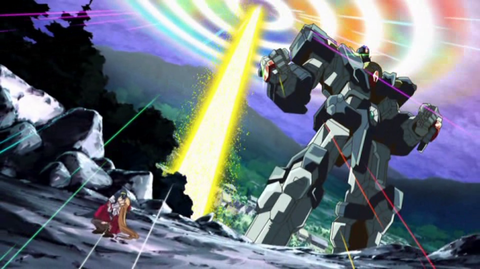
aka Everyone Loves Chikane
The story begins with a typical female ditz named Himeko, who attends a high school that overlooks a small mountain town isolated from the rest of the world. Despite being a complete failure at life, her closest friend is Chikane, the typical tall, beautiful, all-star girl that everyone loves.
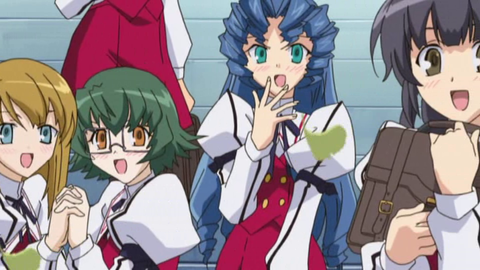
And I do mean everyone…
Coincidentally, they both share the same birthday. As such, Himeko asks Souma, the typical perfect all-star boy and acquaintance of hers from school, to help her buy a gift before Chikane’s birthday party the next day. That night, some random people around town are called out to by Orochi, a dark god sealed away on the moon. As it turns out, both girls are reincarnations of two priestesses that protected said sacred shrine (also on the moon), keeping Orochi sealed. Therefore, killing them destroys the shrine, breaking the seal, releasing Orochi, blowing shit up. These possessed people, called Heads (because Orochi was a 7-headed god), each get their own mech, resulting in hilarious fights.
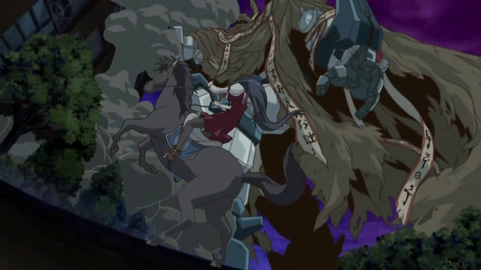
Horse vs Gundam: Who shall prevail!?!?
Souma turns out to be one of the Heads, but does not succumb to evil. Instead, he fights the Heads to protect the priestesses.
This is a show for everyone who loved the first Sailor Moon and Gundam series, but suffered a stroke and thought the two were the same show. The animation is old, really old, even for the era that it was produced in (but to be fair, who can deny the glory of the panning still shot?). Next, the villains are, for the most part, beyond incompetent, I mean the Baka-Test of villainy. Worse still, the main characters are completely mismatched. Chikane is basically perfect, but loves a moron, which is especially taboo, since they’re BOTH supposed to be priestesses. As for Souma, he fights against his fellow Heads, not because he wants to stop Orochi, not because he cares about EITHER Mineko or Chikane, not because his brother has spent his life researching all of this silliness, but because he doesn’t like being used. That’s right, the only reason this storyline even continues is because this guy feels the need to counter-troll, and hard. The only reason for watching this show is to recall other, better anime, that this series tries so poorly to steal from.
Kyokai Senjo no Horizon (Horizon on the Middle of Nowhere)

aka Police Academy: The Anime
Basically, an event in the far future screws up the landscape on earth (for the greener) so much that humanity basically has to start over. Fortunately, humans can still cruise around in floating city-ships, subtly juxtaposed by Edo-style interiors and resident monsters. Since no human civilization is complete without political divides, there are various cities that have aligned themselves with one another against still other cities. As such, various schools, such as Musashi Ariadust Academy, are created to train the next generation of leaders and soldiers.

If you can even call THIS collective of creatures “soldiers.”
At the center of all this silliness is the main character, the School Chancellor and Class President, Aoi Tori, who remains eternally the quintessential bi-shounen pervert.

Why, yes I am fabulous. Thanks for asking.
Tori’s goal in life is to confess his feelings to an android girl who mysteriously resembles Horizon, his childhood friend who died ten years ago. Unfortunately, the city’s leader, Lord Matsudaira, basically hands Tori over to the enemy alliance, the Testament Union. Shit happens, and guess what? Horizon is somehow involved. Silliness and vague romantic antics ensue.
It takes true skill to make a show stand out from the background noise that is modern anime. It takes a special blend of storyline, character design, artwork, voice acting, and timing. The problem is that the pendulum can swing both ways, and this series falls on the worst end of the spectrum. Almost nothing about this show has any redeeming value, and any small parts that would have been valuable have all been crushed together and buried under a mountain of pointless characters, sub-plots, and gimmicks. The show just tries to do way too much, so much that there is almost no direction, and the writers don’t even care. I mean, magic and demons and monsters and airships and androids and anachronisms and schools and fights, and this is all just in the first friggin’ episode!

Two minutes down, 73 to go…
This series goes right on the DEEN List. It’s just abysmal, and there is literally no merit in even trying to watch it.
Tytania
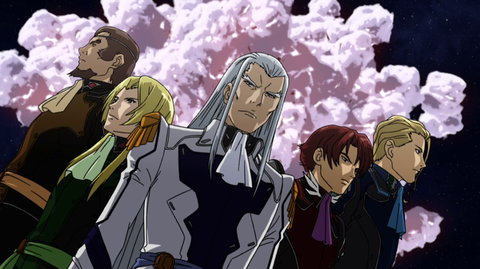
aka Britannians….In….S-P-A-A-A-A-C-E!!!
Once again, in the FUTURE, humans have inhabited all of the Milky Way Galaxy, and various empires have starting popping up. The foremost empire of Voldana is under the control of the clan of Tytania, a family which technically controls no territory but nonetheless is the most powerful and feared group in the galaxy and has been for 200 years. In fact, they’re so rich and powerful that they build castles on top of their castles.
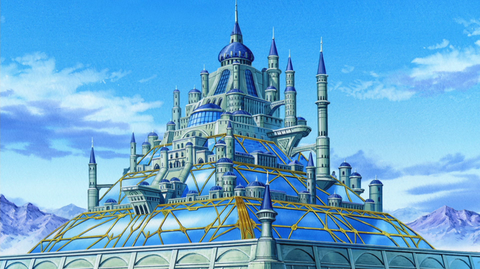
So that everyone in their Court can have their own court.
The clan lord Ajman Tytania has been considering stepping down for quite some time, and the clan’s four Dukes have been positioning themselves to be potentially named successor. While attempting to seize a new technology from the fringe city-state of Euriya, Tytania suffers its first and only military defeat. The man responsible is the Commander Fan Hyulick, who is easy-going in more ways than one.
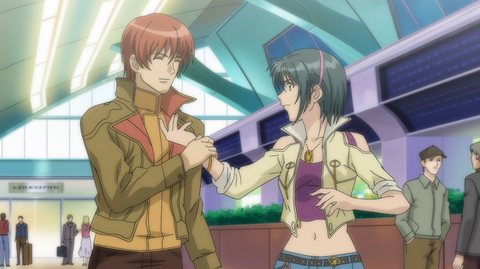
I couldn’t help but notice you reaching for my pants.
Since he was supposed to lose in a token show of resistance, actual victory has resulted in him being sold out by the Euriyan government. Subsequently, Fan sets off across the stars, dodging or escaping from Tytania’s attempts to capture, kill, or recruit him along the way. Although Fan also diligently avoids further opportunities to directly oppose Tytania, his growing notoriety and a lingering affection for a young woman makes that difficult.
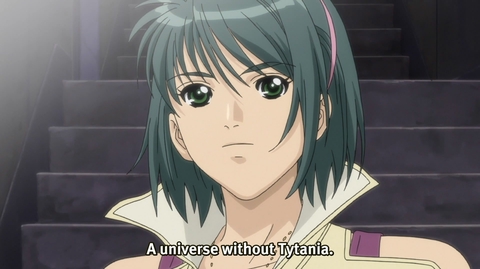
A universe without Tytania is one without fabulousness!
For those who still have yet to see the Tytania OP (which you can’t because YouTube sucks) (which is the single-greatest propaganda OP in the history of anime), one look should tell you exactly what this series is like. That said, the series is…not that bad. Sure, it’s funny, but it’s only that way because it takes itself so seriously. The story is based on an unfinished novel series from 1988-1991, and the animation reflects that time period, even though Tytania wasn’t even released until 2008. The storyline of oppressed peoples rising up against their fabulous rulers may seem pretty cliché nowadays, but if this was actually produced shortly after the novels were published, Tytania would be right at home with the likes of Macross. As such, this series defines itself pretty strictly as a space opera, and ironically one of the better ones in anime. This series may not be Battlestar Galactica, but if you are a fan of the space opera genre, then this show is decidedly worth the watch.
Sky Girls

Plug suits will never go out of style.
Yet again, IN THE FUTURE, humanity is nearly wiped out by alien invaders called WORMS. Although the aliens were narrowly defeated, the widespread use of thermonuclear weaponry ruined much of the earth, as well as annihilated almost all of the middle age demographic (ages 18 – 34). As such, the global military is made up largely of young teenage girls…for some reason. However, one particular group is specifically selected to pilot giant flying exoskeletons called Sonic Divers.
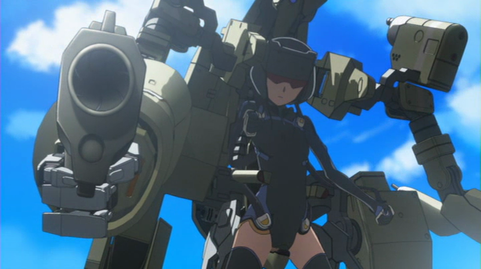
Which is in NO WAY a direct rip-off of Infinite Stratos…
Currently the group is only comprised of 3 girls: a kendo student named Otoha, a bookworm named Karen, and a fighter pilot named Eika. Although their relationship gets off to a rocky start, the re-emergence of the WORMS means that they have to work together, or what’s left of humanity will be eradicated.
Designed to be the prequel to Strike Witches, this series is about as good, which is terrible. The first 3 episodes come off as slice-of-life, which always seems to make for a lame segue into military themes. Stranger still is the fact that the commanding officers are so laid back, while the underlings (most of them civilians) all act so seriously. This feels especially weird when the WORMS actually come back. Aside from that, the storyline is weak, the characters are far from memorable, and the premise is the same gimmicky children-mecha rehash that has been failing for the last 10 years. That aside, it’s moe girls doing moe mecha things, which apparently makes it no worse than No. 6.
R-15
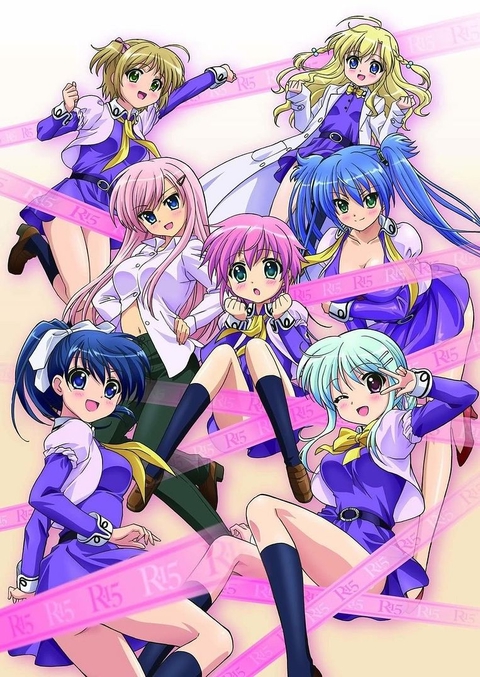
Not intended for younger writers.
In modern day Japan, the prestigious Inspiration Academy Private High School has gathered prodigies from around the country in order to provide the best education possible for Japan’s future leaders. Their fields of genius run the gamut from math and science to sports, artistry, photography, music, and literature. Then there’s Takuto Akutagawa, a boy whose specialty is writing erotica. As such, he’s usually ostracized, except when he’s reporting for the school newspaper. This gives him a chance to meet many interesting people, which turns out to only feed his hyperactive imagination. One day, he happens to listen to a girl named Fukune Narukara playing a clarinet. However, a test sidewinder missile malfunctions and Takuto leaps over to protect her. Misunderstandings and fan service ensue.
R-15 remains one of the great tragedies of 2011. All throughout the first three episodes, Takuto always has his brain preoccupied by increasingly cheesy sex scenes, which continuously detract from the actual episode. The show does this almost to the point where it’s pointless to even watch the show. Then I started to notice things, namely Takuto’s writing. Practically every girl Takuto encounters assumes that his work is just thoughtless porn (and if they could peer into his brain, they’d be right). However, after every fantasy, he furiously begins writing a scenario, and every single one of those girls blush when they actually start reading it aloud because it sounds like pure poetry.

These sentences read like Harlequin romance novels.
Now, I had just watched Anonymous mere days before R-15 was shown at the club, so I may have some bias. The main character of the film (who the film portrays as being the actual writer of William Shakespeare’s plays) is a wealthy English noble, and plays were considered by the aristocracy to be immoral at the time. His wife (a Puritan through and through) asks him why he continues to write these atrocious manuscripts, and he says that he constantly hears the voices of his characters ringing through his head, and only putting their voices to paper silences them.
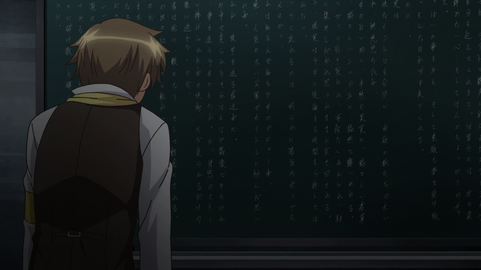
Sound familiar?
I almost want to say that Takuto has a mild form of schizophrenia because not only does he experience these hallucinations frequently, but they are also about people and scenarios that are completely different from the ones he currently experiences in real life. There is a near-absolute disconnect, which is why his complex writing style seems especially strange.

Somehow he’s the manliest character.
Then there’s the rest of the cast. Takuto’s close friend Ritsu is a mathematician that seems very loyal, but also experiences a neurological quirk similar to Takuto. Meanwhile, Fukune, although very skilled with her clarinet, is oblivious to her surroundings and to general human contact on all but the most subconscious levels. Meanwhile, you have Takuto’s expert photographer who is constantly scheming to belittle Takuto and his reputation because he doesn’t fit her world views. That’s only 4 people out of an entire school of students that are more savants than geniuses. Watching how they interact (and choose NOT to interact) could create a very complex story. If I described R-15 based on these character designs alone, a lot of people would be interested in watching the show. However, the series all boils down to shameless fantasies, fan service, and sight gags.
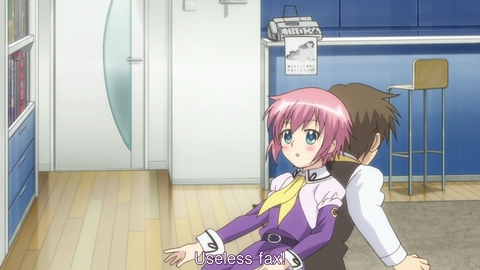
And who the hell faxes porn!?!?
R-15 frustrates me, possibly even more than No.6, because it’s a show that I know could been interesting and clever, and maybe even memorable, but it instead took the harem route.
M.D. Geist
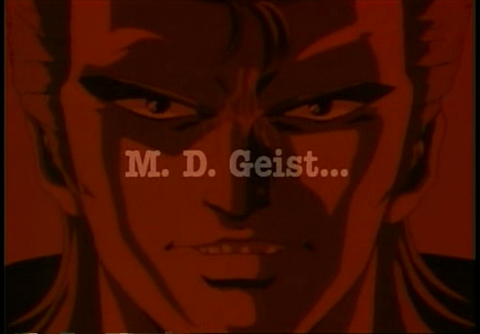
Short for Monumental Douchebag
What’s that you say? You need more FUTURE? Well at some point in time between R-15 and Tytania, various planets inhabited by humans still squabble with their own internal wars. Among such planets is Jerra, where the Regular army engages in unceasing war with the rebel Nexram army, resulting in a loss of a large percentage of the planet’s population. During this time, the Regular army developed many secret programs, including one called Most Dangerous Soldiers (M.D.S.). These soldiers were genetically engineered to be unstoppable killing machines, but shockingly, they proved to be unstoppable killing machines. As such, the project was terminated and so were the soldiers. However, the wildest of the bunch, M.D. Geist, was instead placed in an orbiting prison satellite until such time as he could become a contributing plot device.
So one day, the satellite prison crashes down on Jerra, and Geist emerges from the crater Terminator-style. He then sets out to scavenge until he can contact the Regular Army. In one ruined city, he encounters some Mad Max rejects and promptly kills their leader. The second-in-command, a woman named Vaiya, invites Geist to work for her in order to gain more territory. Later, they come across a giant tank operated by the Regular Army, which is being attacked by Nexram forces. Again, Geist tears shit up. As a token of appreciation, the leader of the Regular army unit tells Geist their mission. In another “what could possibly go wrong” Regular army program, a secret automated facility named Brain Palace was created to ensure that the Nexram army would never win the war.
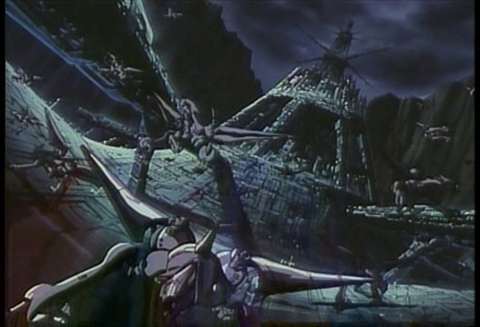
Brain Palace – Sadly, neither brain-shaped nor made of brains.
At a preselected point in time, Brain Palace would activate the Death Force, an army of killer robots designed to eradicate all life on Jerra. Realizing that this idea is beyond stupid, the Regular army sent out this unit to infiltrate and disarm Brain Palace. Geist wants in, so they let him fight. However, the unit’s leader conveniently knows about Geist’s past, having heard of the M.D.S. program. So while everyone else is off dying at the hands of Brain Palace’s security forces, the unit leader descends towards the master control, leaving Geist to fight a 3-stage robot boss. Although the unit leader managed to successfully stop the countdown, Geist managed to defeat the boss. As a token of his gratitude, Geist crushes the unit leader’s face. Vaiya, who conveniently survived by hiding during the fight, made her way to the master control to congratulate Geist. Unfortunately, a killing machine like Geist loves a challenge, so he manually activates the Death Force right then and there. The Death Force then proceeds to kill all life on Jerra, and Geist is there waiting for a fight.
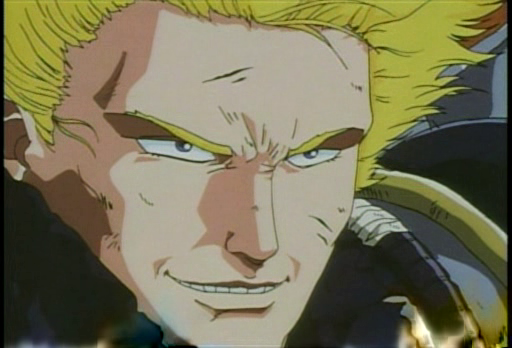
Classic 80's Trollface
Later, Vaiya wanders the ruined cities with a bunch of other nomads scrounging for food and supplies when they encounter some of the Death Force units. These insect-like creatures are controlled by more sophisticated humanoid robots. Worse still, these units can use human flesh as energy and can self-replicate. Fortunately, another super-strong human arrives to defeat the units. As it turns out, one other M.D.S. survived termination, named M.D. Krauser. The difference between him and Geist is that Krauser has an insane god-complex and Geist is…just insane.
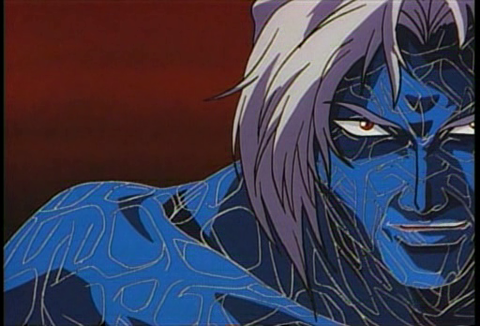
Also, Krauser is blue (dah-bu-dee-dah-bu-dye).
Unlike Geist, Krauser has rounded up the last human survivors on an island fortress that can mask its presence from the Death Force. The head scientist at the facility, Dr. Breston, knows about Krauser’s past, for he not only worked in the M.D.S. program, he created Geist. While the other humans unquestioning follow Krauser, Breston tries to find Geist while continue to maintain and improve Krauser’s body. As such, he sends out his cyborg named Eagle to capture Geist alive. Meanwhile, Krauser has taken a liking to Vaiya, but she freaks out after noticing that Krauser has the same tags as Geist. However, her mind has repressed almost all of her memories involving Geist, which Krauser desperately wants to find. After barely capturing him, Breston analyzes Geist and realizes that Geist’s body and mind function basically like a Saiyan (evolving in battle, wanting only to fight, contributing very poorly to the storyline, etc.). Thinking that it would be a great idea not to kill Geist, Breston decides to continue researching him. Of course, Geist eventually wakes up and kills Breston and everyone else standing between him and Krauser.

The most dangerous Robocop.
So Geist and Krauser have a little skirmish on a tower bridge, but Geist survives being thrown off the bridge by Krauser. Vaiya watches the fight from afar, and remembers everything. She quickly rushes to Krauser, telling him everything about Geist, but when she starts ranting about Geist being a death demon that not even Krauser can kill, he sends Vaiya to the rubber room until she becomes less crazy.
Later, the rest of the humans have devised a plan to wipe out the Death Force. Using the same technology that has masked human activity, Krauser’s men have created a device that mimics human activity in an abandoned desert city. The plan is to lure all the machines to this abandoned city and detonate a Jignix bomb, which acts like a thermonuclear bomb. The problem is that these people are idiots, and they expect the bomb to be assembled and detonated manually and on site. As for Geist, he’s hiding out while Eagle, who wants revenge on the humans for forcing him to work in the salvage pits, gathers weapons so Geist can finish his fight with Krauser. It seems that the remaining military force on Jerra (Nexram, obviously) that is aiding the other humans wants to detonate the Jignix bomb with Krauser still in range, because they want to control Jerra themselves.
At the trap site, the bomb gets assembled and everything is set, but then Geist comes and fucks things up by killing the soldiers, destroying Krauser’s cloaking device, and alerting the entire Death Force. Geist then proceeds to lead the killer robots to the human fortress, but the dying soldiers manage to set off the Jignix bomb. Unfortunately, Geist, Krauser, and a bunch of Death Force units make it just outside of the blast radius. So while the Death Force fills the hallways with human bodies and Eagle (for some reason) rescues Vaiya, Geist and Krauser have a good old fashioned fist fight (in glorious black-and-white).
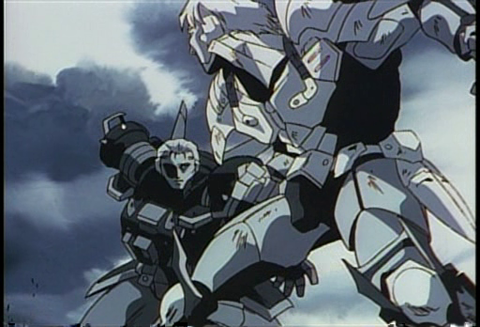
This fight is so artful.
Geist is on his back and down for the count, and Krauser has broken off a metal pipe to stab him with. Then suddenly, as if compelled to suck, the remaining humans run up to inundate Krauser with their pleas to be saved from the Death Force. This gives Geist enough time to try rushing Krauser while backed by a giant Death Force unit. In desperation, Krauser thrusts the pipe at Geist, but in the process he also impales this stupid, STUPID boy who inexplicably gets 3 seconds of screen time every 10 minutes.

How do you do that? This kid would have to be literally in mid-air between these two.
Of course, this happens in front of everyone, and Geist has to be a bastard by saying (with a pike through him) “You’re not qualified to be a god, Krauser.” Following some pretty epic screams from Krauser (which is really the only reason anyone should even suffer watching 85 minutes of this movie), the fortress inexplicably explodes, taking out the rest of the Death Force. There’s a completely random shot of Krauser who has somehow been vertically impaled, and then there’s a shot of the last remaining humans on Jerra (Eagle, Vaiya, and 6 extras). And what of Geist? His body is never shown, but his trademark helmet sits haphazardly atop a mountain of skulls at the base of the ruined fortress.
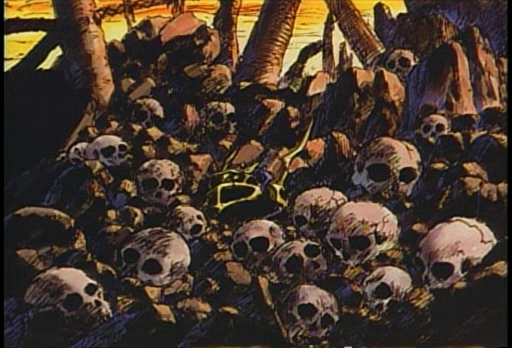
Maybe leave this image out of the Jerra travel brochure.
Ah yes, M.D. Geist. This is one of the most infamous anime, so much so that it was supposed to fade from memory like a bad dream (and as we all know, the most horrific of nightmares simply fade over time). Alas, the advent of the internet means that nothing can remain truly lost, and Gene had to dig very deep down in the sewage to find this movie. M.D. Geist was produced by the now-bankrupt Central Park Media, a company responsible for other…memorable anime such as Patlabor, Utena, and Grave of the Fireflies (and in case you weren’t depressed enough, 60% of the companies’ other releases were C-rank hentai films). This was the work of a first-time director, and it’s painfully obvious that he had no idea how to tell a story, so he strung along a bunch of things that looked cool (80’s cool) and worked from there. Geist was created in the time before computer animation, so it offers something very valuable: physical evidence of the animators’ frustration. They knew that this project was utter garbage, and they were even at the point of mutiny. As such, the film is littered with poor animation, panning still shots, random cut scenes, and the most generic of action scenes. The voice acting isn’t quite as bad, but it’s still pretty awful (especially the opening scene in episode 2 where the guy basically screams a recap of the first episode). The only bright spot here is Krauser, and to a lesser extent Vaiya, who both at least strive for a semi-competent performance. Then there’s the story, or rather lack thereof. It’s basically a chronicle of Geist doing what he loves, which is tear shit up and ruin everyone’s lives. If nothing else, Geist should be revered as one of the greatest trolls of all time, having unleashed a killer robot army to slaughter an entire planet full of people FOR FEAR OF BOREDOM. So remember, no matter how bad a modern anime gets, just remember: at least it’s not M.D. Geist.
Wakfu
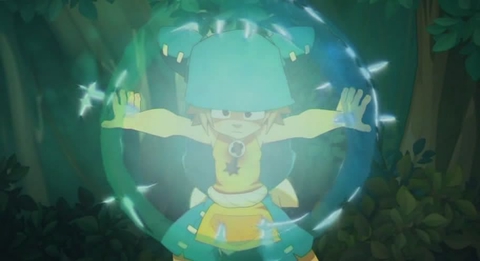
In before MMORPG anime.
In a time and space different from our own, this show opens with an old man named Grougaloragran pushing a baby carriage through the woods.
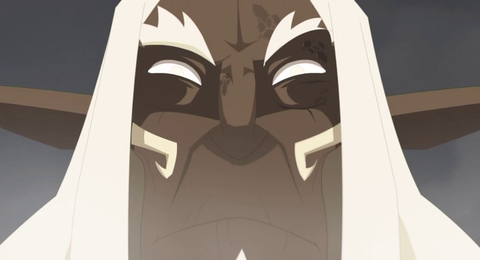
Say that 3 times fast, IN FRENCH.
After dispatching with three short robbers, he then encounters a powerful time mage called Noximilien. Despite his medium stature, he insatiably searches for Wakfu, the life force the fuels this world. After attacking the old man, Grougaloragran soundly torches Noximilien and goes on his way.
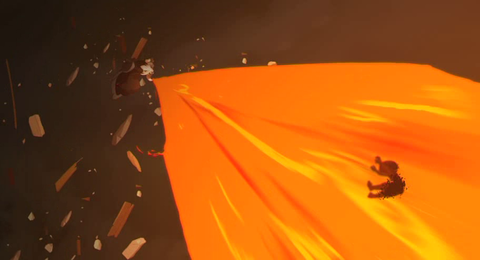
I’d say at least medium well.
Fortunately, Noximilien is also a machine, so he survives his roasting, and discovers that the old man is actually a dragon (the greatest source of Wakfu). Grougaloragran takes the carriage, with a small boy inside, to a bounty hunter, leaving with it a note and some magic runes. Realizing the significance of this child, the man gives up his trade and becomes a baker and cook. Cut to years later, and the baby has grown into a young boy named Yugo. One day, some trouble comes to the cook’s home/restaurant, and (with the help of some acquaintances) they defeat the intruder. Earlier that day, Yugo becomes aware that he can teleport items Portal-style.

Ironically, the bakery sells no cake.
Then Yugo finds out that his family is still alive. So Yugo sets out to find his family, and Noximilien sets out to find Yugo (who also possesses a ton of Wakfu).
Yes, Wakfu is a French animation (i.e. NOT ANIME), but Gene’s an ass, so that’s what was shown. The animation is actually pretty unique, especially for the target age group. Unfortunately, the style is a bit hard on the eyes, so I wouldn’t recommend watching marathons of this style. The main character is just a kid (how appropriate), so there won’t be any mind-blowing concepts here (although thankfully there haven’t been any friendship speeches yet). However, the storyline is typical MMORPG, which means the show will be long, slow, and painfully episodic. Worse still, it makes some not-so-subtle plugs for the actual game that this show is based on. Then again, generations of children have grown up on endless series, so it’s pretty standard fare for the target audience. If you have children (and let’s face it, no anime-loving engineer has children), then you might, might want to consider this.
Megas XLR
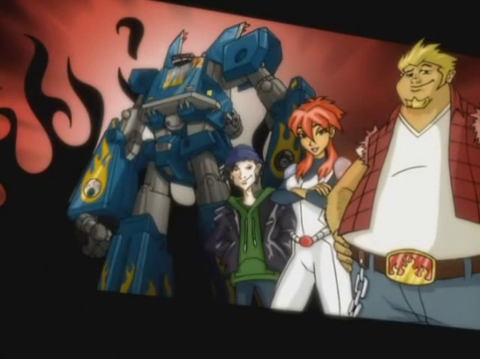
Chicks dig giant robots.
In the future (but before M.D. Geist), humanity tries to fend off the invasion of the Glorft, a race of Chthulu-like beings that pilot mechs. Kiva, a human soldier, manages to capture and remodel the Gloft prototype mech known as M.E.G.A.S. The humans’ plan is to send her and Megas back in time three years in order to change the outcome of their pivotal battle against the Glorft. However, Megas is fired upon in transit, rocketing it at random through time. Warmaster Gorath, the leader of the invasion forces, orders the alien mother ship to follow Megas through the time rift.
Unfortunately, the mighty Megas ends up in the worst place imaginable: Jersey City. As it so happens, an expert mechanic named Coop finds Megas buried in a 60-year old salvage yard and buys it for $2.
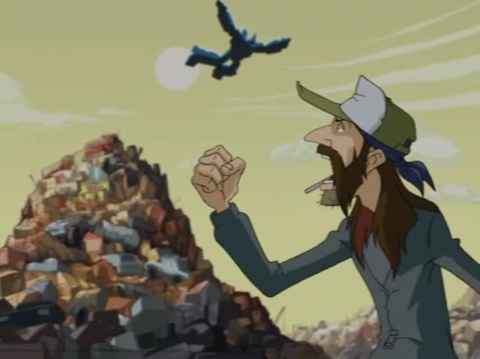
Yeah, flat-rate's a bitch.
After retrofitting it Jersey Nerd style, he shows off Megas to his best friend Jamie (your token Jersey weasel). After imagining what they could do with their shiny giant robot, they start it up, which activates the alarm system. Kiva, accompanied by two escort robots, immediately teleports through the time rift and demands that Megas be returned. In true Jersey fashion (but without the Jersey accent), Coop responds that it’s finders-keepers. Using his life-long video gaming skills, Coop defeats the escort robots. Although surprised by Coop’s success, Kiva rather effortlessly gets into Megas’ cockpit, but she finds that the mech has been modified beyond her capabilities.
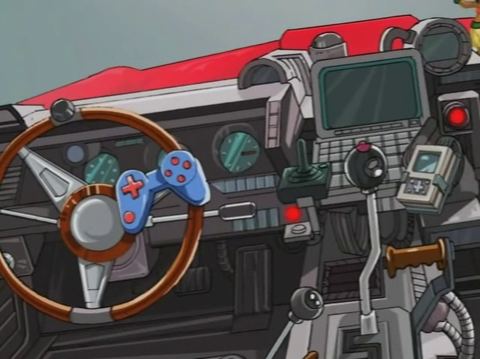
Can't tell if Coop is crazy or Mines engineer.
Realizing that she can no longer pilot Megas, Kiva charges Coop with the task of defending the Earth (and to a lesser extent Jersey City) from the Glorft, aliens, monsters, robots, and any and all combinations thereof.
Megas XLR symbolizes everything great and good about the 1980’s and early 1990’s. Besides being one of only 3 Cartoon Network original shows centered around actual adults, the show’s target audience (early teenagers) can actually enjoy this show as much as the people who grew up in the 80’s and 90’s. The landscape is littered with pop-culture references, and several of the episodes parody the most memorable movies and anime of our childhood. To be honest, this show is so identifiable because it animates the silly things that people imagine when they watched the reference shows. Most of the other episodes find some new and horrible way to bash on life in Jersey, but with the added complexity of owning a giant robot. The only real constants in this show are that Coop is going to tear shit up PS2-style and you’ll laugh at least 3 different times every episode. The cruel irony is that Megas XLR made Jersey seem kinda cool, but then Jersey Shore ruined it again.
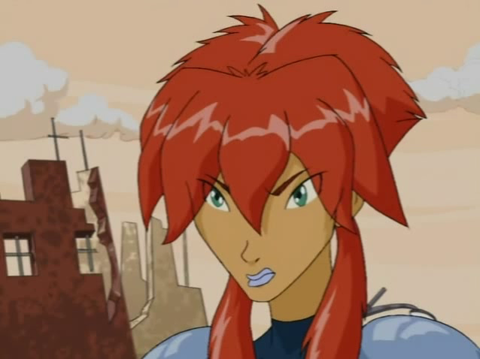
Fucking Jersey.
The animation style borrows a lot from anime as well, especially with fight scenes and character designs (Kiva in particular). Even the music has that 80’s feel (the rock and heavy metal kind, not the keyboard and hair metal kind). Also, Steve Blum and Wendy Lee voice the main characters (in case you happen to watch any dubbed anything). Point being, if you like crash courses in 80’s and 90’s nostalgia and you like giant robots (which chicks dig), then you should definitely give Megas XLR a watch.
My Little Pony: Friendship is Magic
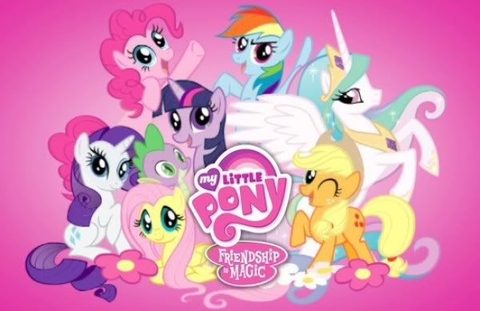
Fuck you, Gene.
Friendship Is Magic takes place in the land of Equestria, populated by varieties of ponies, Pegasus, unicorn, and other creatures. The central character is Twilight Sparkle, a unicorn pony sent by her mentor Princess Celestia, ruler of Equestria, to the town of Ponyville to study the magic of friendship. Sparkle initially resents this assignment because worried about the foretold appearance of Nightmare Moon. When Nightmare Moon does appear, vowing everlasting night and causing Celestia to disappear, Twilight sets off with five other ponies—Applejack, Fluttershy, Pinkie Pie, Rainbow Dash, and Rarity—to obtain the Elements of Harmony and defeat Nightmare Moon. Later episodes follow Twilight and her friends dealing with various problems around Ponyville.
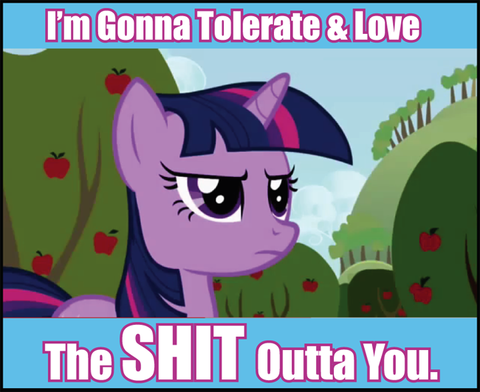
My Little Pony, the cherished favorite toy line of Gene’s teenage years, is also a cartoon series. Although the series originally aired in 1986 with the most mindless of premises, the franchise was reborn in 2010 to appeal to the latest generation of more intelligent, sophisticated pre-teen girls.
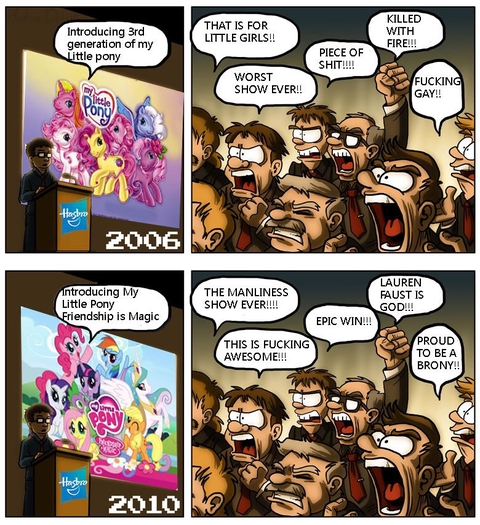
As well as unsophisticated internet trolls.
The animation itself has been updated, but it’s still the same silly Americanized style of most current kids programming (and the Viva Pinata look doesn’t help). The characters themselves are far more realistic because they act like teenage girls do.

Which is sweet and considerate some of the time and vicious and conniving most of the time.
Some of the conversations are clever and even witty at times. That said, the show’s content is actually relatable (as least to the target audience), which is a huge step up from a lot of American children’s television. While this show is by no means Bakemonogatari, it’s rather easy to see human versions of these characters grow up to become the girls in Bakemonogatari.
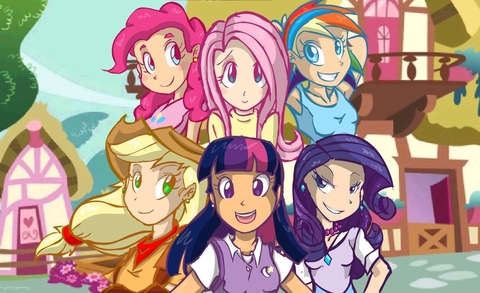
And then shit got real…
With that, the reviews from Fall 2011 are finally complete. Now I just have to catch up on the last two weeks of reviews (oh yeah, wearing down the rock). In the meantime, why not help Chris and Chaeha validate their decisions for the top anime of 2011? Because if you don’t I’ll withhold more reviews, that’s why. Now, if you’ll excuse me, I have to hurry and save my MegaUpload archives from government seizure.
Gene · January 21, 2012 at 9:53 am
Chris · January 21, 2012 at 1:37 pm
Did anybody else read this entire thing in Matt’s voice?
That said, I applaud you for reviewing this many bad anime in a single sitting. Furthermore, I applaud you for actually figuring out what happened in MD Geist.
Kannazuki no Miko, Horizon, and Sky Girls were all about as good as I expected them to be (especially Horizon, which NEVER SEEMED TO FUCKING END I SWEAR THOSE EPISODES WERE ACTUALLY LIKE 45 MINUTES A PIECE). R-15 was almost funny, but as you noted, it devolved into standard boring harem. Tytania was actually pretty interesting, in a weird political Sentai kind of way. MD Geist was hilariously bad, and it feels unfair seriously reviewing it. I didn’t pay any attention at all to Wakfu and MLP, so for all I know, they were the greatest shows ever, but I don’t think they were. And Megas XLR is amazing, and if anyone disagrees, fuck you.
Look forward to the next one.